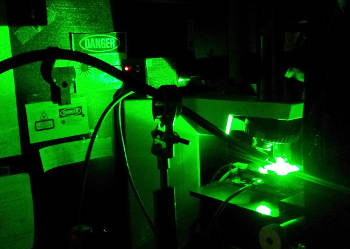Market leaders in temperature controlled microscopy, Linkam Scientific Instruments report on the use of their temperature controlled stages in the authentication of artwork at the Technical University of Denmark.
 The Linkam stage (illuminated right) together with Raman spectroscopy system for the study of pigments in works of art – Technical University of Denmark.
The Linkam stage (illuminated right) together with Raman spectroscopy system for the study of pigments in works of art – Technical University of Denmark.
With the best part of half a million visitors every year, The Ny Carlsberg Glyptotek is the showcase for some of the most important cultural heritage artwork in the whole of Denmark. Established in 1882, it is an internationally renowned museum situated in the heart of the capital city of Copenhagen.
The museum is built around the personal collection of art that belonged to Carl Jacobsen, the son of the founder of the Carlsberg Breweries. The Glyptotek houses over 10,000 artefacts including some of the world’s rarest sculptures and paintings that date back to the 19th and 20th centuries by geniuses such as Monet and van Gogh.
Pieces of such brilliance and importance of course evoke a high level of emotion and therefore require a lot of careful preservation work and intrinsic research carried out on them to ensure that they stay as close to the original state as possible. This is where the worlds of science and art work hand in hand to ensure that the beauty of such artefacts can be enjoyed by all of those who come to see.
Professor Rolf Berg and his team at the Technical University of Denmark have been conducting analysis in co-operation with the Glyptotek and other local institutes to study colour pigments on some of the works of art displayed at the museum. Professor Berg has used Linkam stages in combination with RS (Raman spectroscopy) and SERS (surface enhanced Raman spectroscopy) to identify very subtle changes in the pigmentation of colours of a sample all within a carefully controlled temperature environment.
The importance of this work has not been lost on Professor Berg who has helped examine priceless historical pieces such as mummies, statues, pottery and paintings. He says “Works of art, statues, paintings, ceramics, etc. commonly have solid color grains which can provide important information on the origin, authenticity, etc. Our project included a study - with different instrumental techniques – on self-made and authentic pigments and pigments directly on works of art. The method is non-destructive. The project gave the opportunity to study new revelations about art and color pigments and the chance to try modern spectroscopic equipment in collaboration with other universities.”
Looking ahead, the importance of authenticating and preserving such historical artefacts will become more and more vital. It is the work of Professor Berg and his peers that will help ensure that these pieces will still be around for generations more to come, see and enjoy.
Visit Linkam at www.linkam.co.uk and learn about the broad range of applications in the field of temperature-controlled microscopy.